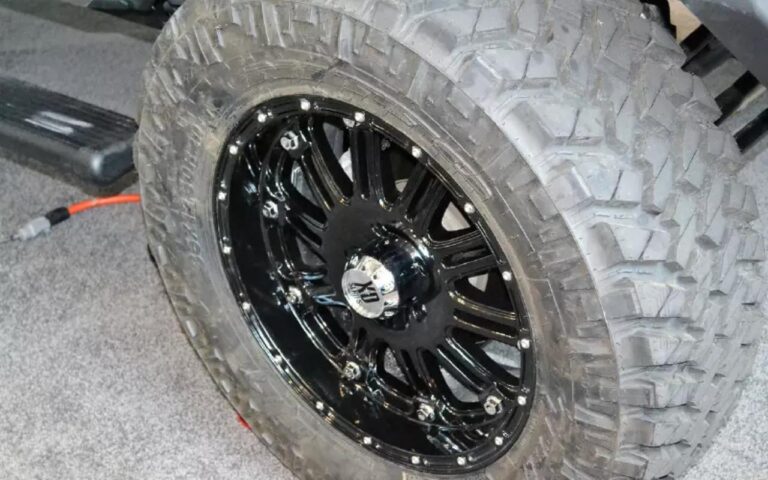People nowadays are lifting their vehicles not only for aesthetic purposes but also for practical reasons. Whatever your reason, you must install the right lift to avoid damaging your car. What lift do you need for 33-inch tires?
Ideally, you will need a minimum of 2.5 to 3-inch lift for 33-inch tires. On top of this, you might also need additional trimming of fender liners and body mounts to achieve a perfect fit.
Sizing up vehicle tires is getting popular. Others just want to improve how their car looks and that about it. Some do it for practical reasons, like enhancing the off-road capabilities of their rides or improving their road visibility.
The most common choice for SUVs is a 2-inch lift for the rear wheels and around 4-inch for the front wheels.
Read on to explore further options for your 33-inch tires.
Can You Fit 33-inches Tires Without a Lift?
Depending on our vehicle modem and the tire you use, you may fit 33-inc tires on your vehicle without a lift. You need to ensure that there is enough clearance to avoid your tires rubbing the vehicle’s mudguard.
For instance, you can fit 33-inch tires on a Toyota Tundra vehicle without the need for a lift, provided that the tires are not too wide and do not feature an overly aggressive tread pattern. However, there might be some back clearance issues if you take your vehicle to some trails.
If you want to learn more about the possibility of raising your SUV with 33-inch tires without a lift, I found a good thread where you might get some helpful insights.
You can also find another successful test of fitting 35-inch tires without a lift here. So, it does work on some vehicles. In this instance, the testers mount the tires on Wrangler JK.
During the testing, the tire rolls perfectly on fine roads. However, when the vehicle encounters some trail, curb, or potholes, some rubbing occurs.
Thus, we can conclude that mounting 33-inch tires without a lift can be no issue. It would fit for sure. However, there will be some rubbing issues you will encounter due to not having enough back clearance.
Therefore, if you plan to fit 33-inch tires on your vehicle, you should use a lift. As you learned, the best lift you can use for this tire size is between 2.5 to 3-inch.
Can I Fit 33-inch Tires with a 2-inch Lift?
As I mentioned in the earlier section of this article, the ideal lift for 33-inch tires is between 2.5 to 3-inch. However, if you have a 2-inch lift, it would still likely work. Then again, you would need to ensure enough clearance; otherwise, our vehicle would suffer damages.
This article features the possibility of fitting 33-inch tires with a 2-inch lift. If you want to ensure getting the right fit, get some help from experts at your local shops. You can also get some quality advice on how you can safely lift your car.
Using a 2-inch lift for 33-inch tires is better than mounting the tires without any lift. Even so, you must still check the back clearance to ensure that it has enough.
Better yet, if you want to make sure that your 33-inch tires fit perfectly on your ride, follow the 2.5 to 3-inch lift suggestion. This range has been tested and proven to be working by many vehicle owners.
Are 33-inch Tires Too Small for a 6-inch Lift?
Technically, it is possible to mount 33-inches tires for a 6-inch lift. However, it can look tiny and silly. More aggressive 33-inch tires may look okay on a 6-inch lift, but regular 33-inch tires may not look good.
I’ve seen an SUV rolling down my town with around a 6-inch lift, but the tires were small. It was a head-turner for me. I mean, who will not notice a lifted vehicle when it passes. Although, during that instance, I thought to myself “it looks funny.” Then I said to myself “I will never do that.”
In this thread, you will see someone who tried mounting 33-inch tires on a 6-inch lift and found that it is too small. Most members in the forum agree that a 33-inch for a 6-inch lift is not aesthetically pleasing. Your car can be a head-turner, but the viewers may not find pleasure when looking at it.
What is the ideal size for a 6-inch lift? You can read this forum as well to find out the best tire size for a 6-inch lift. Experts say that the ideal tire size for a 6-inch lift is between 35 and 37-inch. This article may provide information on the disadvantages of installing small or big tires (over 37-inch).
This comprehensive insight on the lift kit size you need for your wheels and tires may help you. The article answers a few relevant questions concerning the size of rims and tires you want to run, the wheel offset or backspacing, the notch you are willing to allow on the frame, and the trim you are ready to let on the fenders.
How do 33-inch Tires Affect Fuel Economy?
Undoubtedly, lifting lowers the vehicle’s mileage. This is because of several reasons, including increased wind resistance and added vehicle weight brought by the lift and the larger tires.
When you lift your car, it will experience more wind resistance. Wind resistance can cause vehicle turbulence that can directly affect gas mileage due to the pressure differences it creates. Wind pressure can slow down your vehicle. Thus, it reduces your car’s gas mileage.
On the other hand, lifts affect many things, including driveshaft length, steering geometry, brake lines, gear ratios, and overall weight. All of these things contribute to the reason why your vehicle loses some mileage.
Since it is a given that you will lose some gas mileage when you lift your car, you can minimize it. How can you possibly do that?
The most crucial factor to consider is the tire to use. You need to note that tires with aggressive treads (common off-road tires) are known to lower your gas mileage. Your car would exert more effort as these tires have high rolling resistance.
So, if you lift your vehicle, avoid mounting these types of tires to minimize the mileage impact. If you don’t do off-road all the time, you can consider using all-terrain tires.
All-terrain tires can still handle moderate off-road conditions and have better gas mileage and tread life than true off-road tires.
You might also need to get some experts to advise on which type of lift is ideal for your vehicle. The goal is not to make our car super heavy so that the mileage is not so much affected.
As for the 33-inch tires, it does affect the gas mileage, as you already learned above. However, its effect is not the same as the gas mileage impact of the bigger tires, like 35-inch tires or higher.
Related: BFGoodrich All-Terrain T/A KO2 Review
Potential Vehicle Damage Due to Lift Kits
Like everything else, lifts can potentially damage your vehicle if you do not install them properly.
Aside from the possible physical damage that lifts will cause to your vehicle, you also have to face some compromises.
Among the things you suffer from lifting your car are warranty void, compromised handling, fast wear and tear, and higher maintenance cost. Understandably, you are also raising your maintenance cost as you will have to buy bigger and more expensive tires.
You might want to compare the pros and cons of lifting your car. See it in the next section.
Pros & Cons of Having a Lift Kit
Pros
- You can customize the look of your vehicle. It will provide an aesthetic enhancement to your car so that it will stand out from the crowd.
- It will improve how your vehicle handles road challenges and give your vehicle an enhanced off-road capability. Because of the height gained by your car, it can better take bumps, curbs, driveways, or even large potholes.
- Lifting your vehicle will give you a better view of the road.
Cons
- Lifted vehicles will lose some mileage due to the increased weight, oversized tires, and wind resistance.
- Lifting may affect warranties.
- Another thing to consider is the increased maintenance cost. You will need to upgrade the vehicle’s mechanical components, which can be a little costly. Then, you will have to buy more expensive tires.
Conclusion
The ideal lift for 33-inch tires is between 2.5 to 3-inches. However, a 2-inch lif can work, depending on the vehicle modem and the tire you use. If you fit 33-inch tires using a 2-inch lift, you might need to install narrower and less aggressive tires. In some cases, you can even mount 33-inch tires without a lift kit.
If you decide to lift your vehicle, it is also essential to know the pros and cons. Knowing them may help you make a sound decision. The main things you might want to consider are the effect of lifting your vehicle on gas mileage, handling, and maintenance costs.

